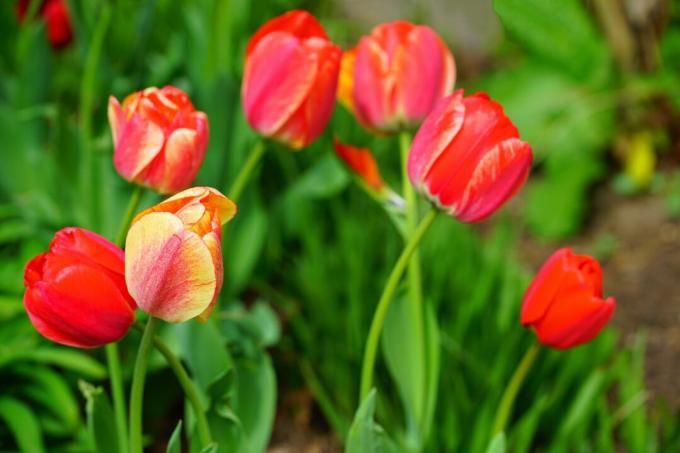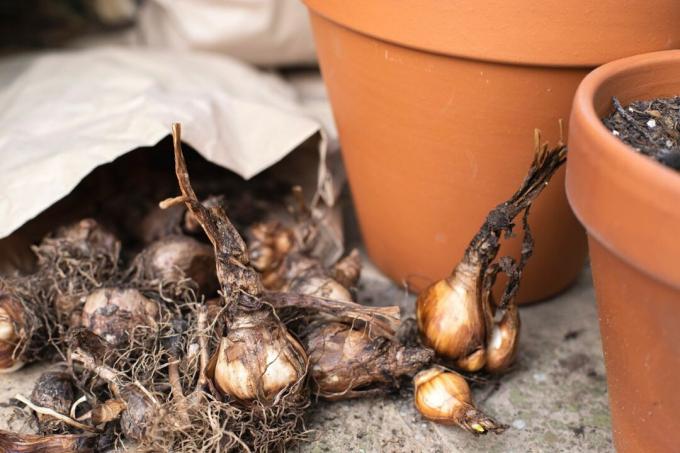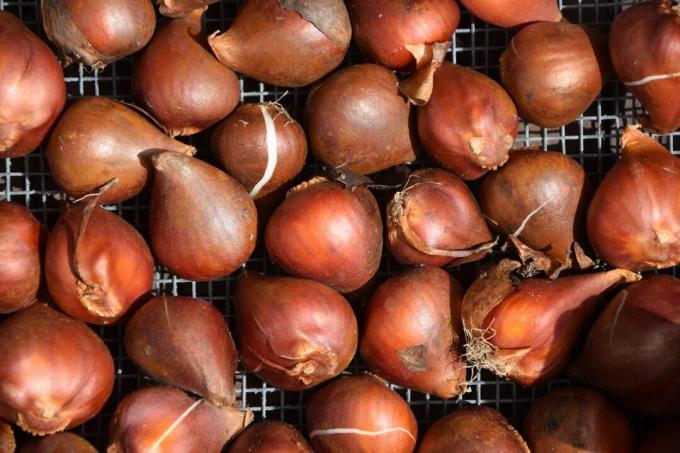Tulips have become an indispensable part of parks and gardens. So that they can bloom again every year, the tulip bulbs should be properly stored and overwintered.

Every year between March and May, tulips bloom in a wide variety of colors. Most varieties are perennial and can be overwintered. Check out this article for the best tips and tricks.
"Contents"
- Which tulip bulbs are perennial?
-
Dig up and store tulip bulbs
- Hibernate tulip bulbs
- Summer tulip bulbs
Which tulip bulbs are perennial?
Almost all of our tulips are perennial, although the individual tulip bulbs are annual. But how does it come about that the tulip blossom reappears every year?
In summer, the mother onion forms a daughter onion under optimal conditions and then dies. The daughter onion is a genetically identical copy of the mother onion and flowers the following year. Only varieties that are sensitive to frost are annual here if they are not overwintered a little warmer. The most robust varieties include Darwin tulips, vidiflora tulips and wild tulips. Lily-flowered tulips also prove to be extremely robust.

In addition to the variety, the location and care also determine whether the tulip blossom is recurring. The place should be sunny, warm and not overgrown. Tulips in particular, as container plants, are at risk of frost, as the earth can freeze completely. In addition, places in the shade and, above all, waterlogging shorten the life of the onions.
Tulips, which can be bought cheaply as ornamental plants in spring, are usually more susceptible than those from specialized perennial nurseries due to the way they are cultivated. With the latter, with the right care and choice of location, you can be sure that the beautiful plants will bloom again every year - but their price is a bit higher.
Dig up and store tulip bulbs
Tulip bulbs must be dug up and kept for summer. For the winter, however, this is not necessary because the onions, which are suitable as garden tulips, are hardy.
Tip: Also in optimal tulip locations, i.e. on well-drained, loose soils and in full sun, the quality of the daughter onion will decrease from year to year until the plant finally disappears.

Hibernate tulip bulbs
Tulip bulbs can be overwintered in the garden soil or in pots at temperatures as low as -23 ° C. They must not be stored in the house, as they need a cold stimulus to form flowers and temperatures that are too warm cause them to sprout too early.
Winter in the garden soil
To overwinter tulip bulbs, they remain in the garden soil. They can be protected from frost with leaves or fir branches.
Winter in the bucket
If the tulip bulbs overwinter in pots or balcony boxes, it is important to keep them away from frost. However, since the onions need a cold stimulus to form flowers, they must not be overwintered in the house. The pot or balcony box should first be covered with fleece and then placed on a styrofoam plate or a block of wood in front of a protective south wall of the house. This will keep the onions warm enough to prevent frost damage. Alternatively, the entire pot or box can be buried in the ground and this point marked. You can then take it out again in spring.

Tulip bulbs in spring:
During the spring, tulips develop their beautiful flowers. In doing so, they draw their nutrients from the mother onion. At the same time, a new daughter onion forms on the mother onion, which must be supplied with water and nutrients. Therefore, fertilization and regular water supply are very important during this time.
As a precaution, when budding begins, you can apply a small dose of primarily organic fertilizer, such as ours, to rather nutrient-poor locations Plantura organic flower fertilizer. This naturally works slowly and thus prevents over-fertilization.
Summer tulip bulbs
Once the daughter onion has developed, the foliage will wither - it is better to cut this off. Then the onions are dug up, cleaned and have to be summerized. Over summer is important so that a mini-size tulip can develop inside the daughter bulb.

Unfortunately, tulip bulbs are prone to rot and pests if they have to spend the summer in moist, compacted, clayey soils or in cool shade. In addition, the daughter bulbs cannot develop well in the soil, because tulips originally come from warmer countries. In this country, the soil cannot heat up as much as it would be appropriate for the young tulip bulbs. So digging up and oversummer is essential for us if you want to see beautiful tulips in bloom every year.
If the foliage is completely yellowed and cut off, the bulbs can be carefully dug up. A digging fork or a spade is suitable for this. The onions have completely changed their appearance since they were set: on the outside there are now the old brown layers of the mother onion.
If these are removed, the new daughter onion appears inside. This daughter bulb can be over-summered so that it will develop new flowers in the following year. If there are also other smaller tulip bulbs on the shell, you can dispose of them with a clear conscience. They are not developed strongly enough and would steal energy from the largest onion. You can then store the tulip bulbs and keep them over the summer.

So that the daughter onion can create a mini-tulip inside in the summer months, it needs storage temperatures of around 20 ° C. The more airy the onions are stored, the better they will keep. Wooden boxes lined with paper are suitable for storing the tulip bulbs. But they can also be laid out on a metal grid or kept in a box with sand. Alternatively, you also have the option of hanging them up in nets. You should regularly sort out rotten and moldy onions. The tulip bulbs are stored until mid-October, then they are replanted in the garden soil or in the tub.
Tip: Label the boxes with the name of the variety and the color of the flower - this way you can correctly assign the tulip bulbs in autumn.

In autumn, the bulbs are planted in airy, humus soil with a planting distance of 15 to 20 centimeters. In addition to these necessary properties, ours is also suitable for planting in a tub Plantura organic potting soilwhich promotes healthy soil life thanks to its high proportion of compost. How do you Put in the tulip bulbs, you can find out in our special article.
Tip: You can still plant the bulbs after October. Be aware, however, that the ground will eventually freeze, which will make digging a hassle.
You can find an overview of other beautiful spring plants in our article about Early bloomer.



